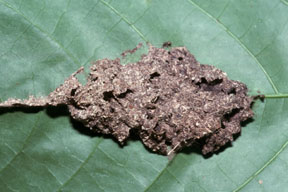

Carton nest of Tapinoma ramulorum inrectum. Individual ants can be seen if you look at the linked original images.
Dolichoderinae, Formicidae, Hymenoptera, Insecta, Arthropoda, Animalia
Range
Costa Rica: lowland wet forests throughout the country.
Identification
Scapes very long, about third of length extending beyond margin of vertex; in full-face view, margin of vertex evenly rounded, not medially emarginate; nests in small carton nests beneath leaves
Natural History
This species occurs in lowland wet forest habitats. It has very distinctive nesting habits and thus is more easily identified in the field than from museum specimens. It makes small carton nests on the undersides of leaves. The carton is coarse, and the nests are usually no more than 2-3cm across and less than 5mmm high. These nests contain workers, brood, and sexuals. They may also cover scale insects, such that multiple scale insects can be found on the leaf surface under the carton, while no exposed scales can be found anywhere on the surrounding plant. Often several nests are found on different leaves of the same plant, in close proximity, suggesting polydomy. On disturbance, several workers emerge and run wildly over the leaf surface for a few seconds, then retreat back inside the nest. Workers may also be found at extrafloral nectaries.


Carton nest of Tapinoma ramulorum inrectum. Individual ants can be seen if you look at the linked original images.
Original combination
Tapinoma inrectum Forel 1908:63. Syntype worker: Costa Rica, forest of Pirris, 600m elevation (Biolley). On a branch of a shrub. Nest in vegetable debris. "dans une branche d'arbuste. Nid en debris de vegetaux."
Tapinoma ramulorum inrectum Forel: Forel 1912:57.
Comments
I have not examined the types of this species but the original description mentions the long scapes, and Biolley's field notes, "Nid en debris de vegetaux," could be interpreted as a carton nest. The name inrectum is currently a subspecies of ramulorum, but should be elevated to species status (if the types match this carton-nesting species).
Literature Cited
Forel, A. 1908. Fourmis de Costa-Rica rˇcoltˇes par M. Paul Biolley. Bulletin de la Sociˇtˇ Vaudoise des Sciences Naturelles 44:35-72.
Forel, A. 1912. Formicides nˇotropiques. Part V. 4me sous-famille Dolichoderinae Forel. Mˇm. Soc. Entomol. Belg. 20:33-58.
Page author:
John T. Longino, The Evergreen State College, Olympia WA 98505 USA.longinoj@evergreen.edu